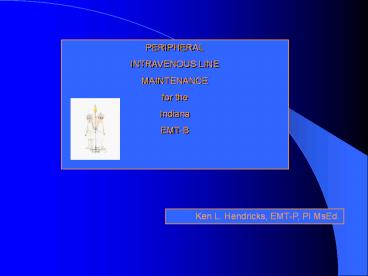PERIPHERAL - PowerPoint PPT Presentation
1 / 19
Title:
PERIPHERAL
Description:
PERIPHERAL INTRAVENOUS LINE MAINTENANCE for the Indiana EMT-B Ken L. Hendricks, EMT-P, PI MsEd. Purpose: The IV maintenance module was developed to assist the EMT-B ... – PowerPoint PPT presentation
Number of Views:132
Avg rating:3.0/5.0
Title: PERIPHERAL
1
PERIPHERAL INTRAVENOUS LINE MAINTENANCE for the
Indiana EMT-B
Ken L. Hendricks, EMT-P, PI MsEd.
2
Purpose The IV maintenance module was developed
to assist the EMT-B manage non-critical patients
who have a pre-established peripheral IV line
already in place when they need transported to in
an ambulance. EMTs may encounter many of these
at home, in long-term care facilities, or in a
hospital setting. These patients may require
transportation to other locations for diagnostic
exams, treatments, or emergency care while the IV
remains in place.
3
ROLE of the EMT
Safely Handle and Transport STABLE patients
with an Peripheral IV already established.
4
Personal Safety Concerns for the EMT-B
- BSI
- Universal Precautions prn
- Avoid Contact with Blood
- Septic Techniques
- Safe Sharps Handling
- Documentation of Exposures
- Follow Up and Treatment prn
5
Required Skills EMT-B for IV Maintenance
- Adjust and Maintain Drip (flow) Rates
- Change an IV Bag using Aseptic Technique
- Discontinue an IV using Aseptic Technique
- Stabilize an IV Site, Equipment, and Tubing
- Proper Documentation of IV Maintenance
6
Goals for the EMT-B in IV Handling
- Keep IV patent and infusing at ordered rate.
- Handle the patient in a manner to prevent IV line
problems. - Monitor the patient and IV equipment that will
identify any IV line complications in a timely
manner. - Complications include infiltrations, clot
occlusions, empty bag, over hydration. - Trouble shoot any IV line complications that
would arise. - Personal Safety
7
IV Transport Considerations for the EMT-B
- Secure Enough Fluid to keep the IV patent
throughout the trip.
8
Purpose of IV Solutions
- Replacement of Lost Fluids (vomiting, diarrhea,
dehydration) - Maintenance of Fluid and Electrolyte Balance (NPO
patients)
9
Authorized Solutions for the EMT-B
- Crystalloid Solutions (D5W, LR, and NS)
- Vitamins
- Sodium Chloride (less than 0.09 concentration)
- Potassium Chloride (lt 20meq/l concentration)
10
UnAuthorized Situations for the EMT-B
- Piggy Back Set Ups
- Secondary Set Ups
- Blood Products
11
Complications of IV Fluid Administration
- Overhydration
- Clot Occlusion
- Infiltration of Fluid into Tissues (exrtravasate)
- Positional IV
- Pyrogenic Reaction
- Allergic Reaction
- Infection
12
Types of IV Cannulas (needles)
- Cannula over Needle (CON)
- Butterfly
- 14-20 gauge (adults)
- 20 25 gauge (pediatric)
- length depends on gauge from ½ - 3
13
Stabilization of IV Sites
- Site must be covered
- Cannula and Tubing Stabilized (using the 2 loop
method) - Initial Stabilization Done by Sending Agency
- Should be on an Armboard
14
Flow Rate Concerns
- Height of the Bag
- Position of the Patients Limb
- Amount of Fluid in the Bag
- Site Location Relative to the Heart
- Altitude of the Patient (psilt with altitude)
15
Calculation of IV Maintenance Drip Rates
Amount of Fluid to be infused x Drip Set
Time (in minutes)
gtts/min
Drip Sets
Mini Set 60gtts/ml (cc)
Regular 10gtts/ml (cc)
Regular 15gtts/ml (cc)
Select 3 Selectable (60, 15,or 10)
16
Example
Order Infuse 120cc/hr of NS using Mini-Drip
Amount of Fluid to be infused x Drip Set
Time (in minutes)
gtts/min
120x60 7200 120 gtts/min 60 60
120 cc x 60gtts/cc 60 min
Adjust the Flow Rate Knob to
120 gtts per min is 2 gtts/sec (use a 15 sec
count to get close, then 1 minute count)
17
Troubleshooting IV Problems Not Infusing
- Constriction above the IV Site
- Tubing or Attachments are Leaking
- Air Venting into Bottles
- Flooded Drip Chamber
- Height of IV Gravity Flow
- DC if Drip Cannot be ReEstablished
18
Required Documentation in IV Handling
- Initial Assessment (including Vitals and Breath
Sounds q 15 or if patient changes condition) - Condition of IV Site (q 15 or if changes occur)
- Amount of Fluid Infused and Remaining in bag q
30-60. - Record urine or emesis output in cc or ml
measures - IV Bag change time and solution used
- Removal (if needed) time, size of CON, and
reason(s) why - Changes in Patient Condition
- Problems with the IV
- Type of Solution and Administration Set
19
PERIPHERAL INTRAVENOUS LINE MAINTENANCE for the
Indiana EMT-B































